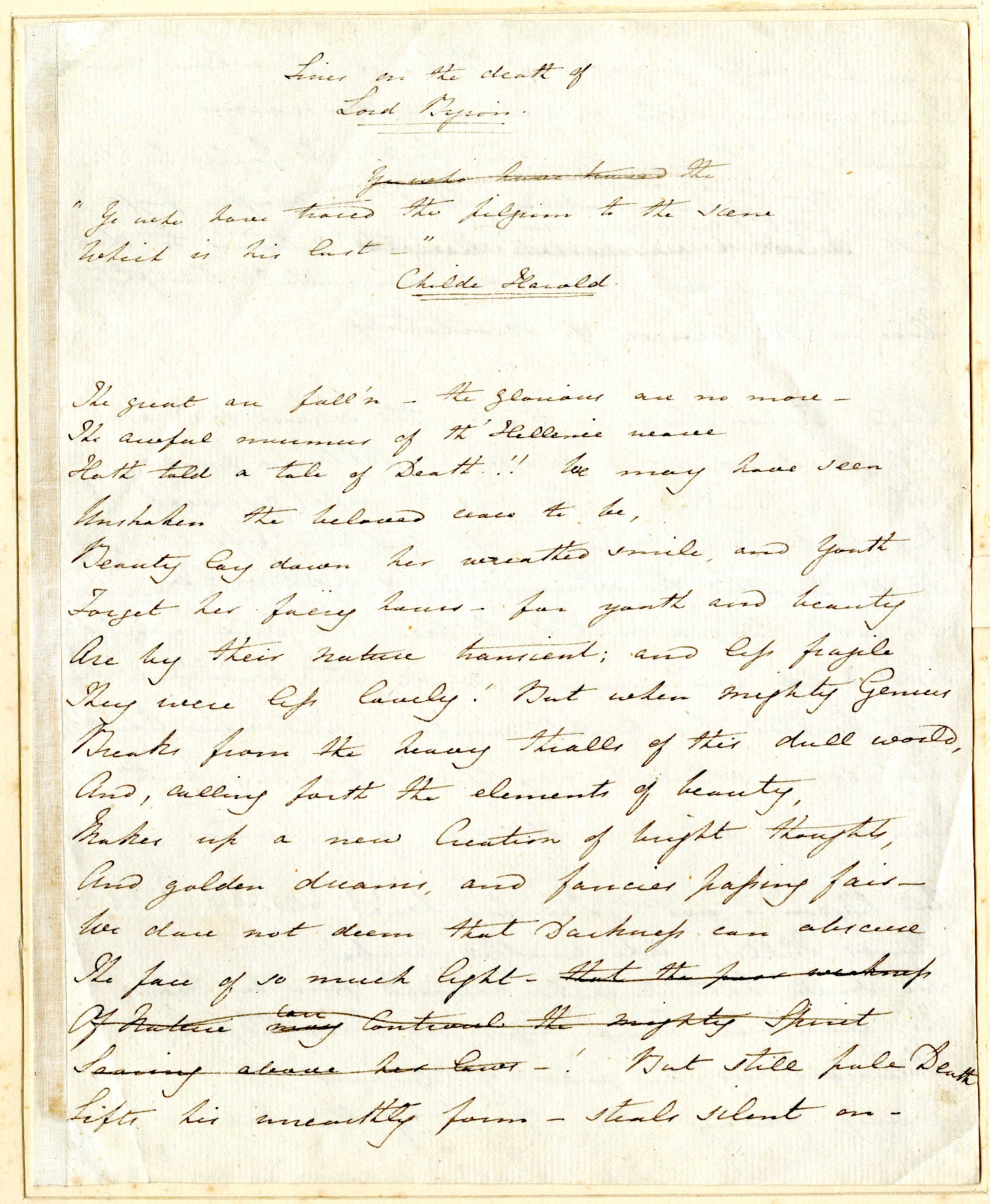Manuscript. Elizabeth Barrett Browning on the death of Lord Byron. [2 p.] Not dated. Holograph, unsigned. Poem of 38 lines with additions and corrections.
Rare Item Analysis: Elizabeth Barrett Browning on the Death of Lord Byron
By Robin Landrith
In response to Lord Byron’s untimely death in 1824, Elizabeth Barrett Browning penned a reflection on his life and work in the form of a poem, simply called “Lines on the Death of Lord Byron.” This particular poem was never published, and the original manuscript of it is held in the 19th Century Collection of Baylor University’s Armstrong Browning Library. The aim of this post is to describe briefly some of the features of this poem, and to indicate just a few observations that might be drawn from it concerning the reception and impact of the life and work of Lord Byron.
Lord Byron was about a generation older than EBB, and gained an unprecedented popularity through his poetry during his own lifetime. The publication of the semi-autobiographical Childe Harold’s Pilgrimmage first ushered him into major literary fame, and he remained in the spotlight (receiving fan mail all the while) until his death at age 36. During that time, he met and established a friendship with Percy B. Shelley; wrote such works as Manfred and Prometheus, among many others; and subscribed himself an ardent advocate of Greek independence, raising and commanding his own army to join the fight. It was during this campaign that he met his end, dying of a fever in Missolonghi, Greece, before he reached the battlefield in 1824.
It was within that same year that EBB wrote her “Lines.” EBB was a young poet at the time, about 18 years old, and she composed not only “Lines” in response to Lord Byron’s death but also a second poem called “Stanzas on the Death of Lord Byron,” which was published in the Globe and Traveller in 1824.[1] The two poems are different in both style and content, the published version being the more formal of the two and the unpublished manuscript reflecting a “more personal and immediate response” to Lord Byron’s death.[2] A true comparison/contrast study of the two poems might be both interesting and fruitful, but cannot be included in this brief post; but both poems do, at least, allow us a glimpse of how EBB, a young poet reflecting on the passing of a great, received and interpreted Byron’s life and work.
One brief note concerning the appearance of the manuscript deserves to be mentioned before getting to the content of the poem itself. One of the striking features of the manuscript is the very simple fact that certain lines are crossed out, some to be re-written and others to be omitted entirely. Two such alterations occur in the poem proper, and another occurs at the top of the first page, where EBB seems to have begun writing the epigraph in the center of the page, thought better of it, and wrote the very same thing beneath it, a little further to the left. It is a simple detail, to be sure, but it does serve as a reminder of what can often be overlooked in the polished, printed final product of a published poem: namely, the process of writing, which we can see at work even among the most accomplished of poets.
Much can be said about the poem itself. But I will point out just one of its main features here, namely EBB’s reflection on the tension between transience and immortality that permeates the poem as a whole. She writes in lines 6-7, “…for youth and beauty / Are by their nature transient,” indicating, in a word, that it is no shock when these things pass away; “But when mighty Genius / Breaks from the heavy thralls of this dull world…We dare not deem that Darkness can obscure / The face of so much light” (8-9, 13-14), suggesting that there is some kind of immortality – or the hope, at least, of this immortality – that accompanies the work of a great poet. Concluding the stanza with this: “While the loved Poet, that on classic page, / Hath left undying words, returns to die – / And generous lips, that spake immortal thoughts, / Close in the silence of Mortality” (19-22), EBB solidifies the notion, developed throughout the poem, of the immortalizing power of the written word. In this way, we can gather from EBB’s response to Lord Byron’s death that to her, as to many, his work was something profound and enduring; and through her words, not only does she point to the enduring nature of the words of the poet himself, but also contributes to that endurance by celebrating, in her own “undying words,” the genius of the poetry of Lord Byron.
[1] Browning, Elizabeth Barrett. The Works of Elizabeth Barrett Browning. Ed. Sandra Donaldson, Marjorie
Stone, Beverly Taylor, and Rita S. Patteson. Vol. 4. London: Pickering & Chatto, 2010. 138-140. Print.
[2] Ibid. 138


